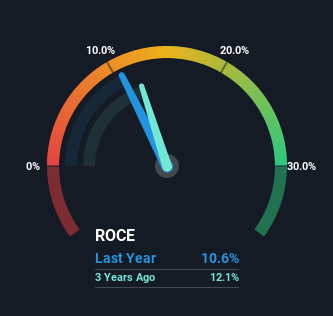Be Wary Of Kanpur Plastipack (NSE:KANPRPLA) And Its Returns On Capital

If we want to find a stock that could multiply over the long term, what are the underlying trends we should look for? Amongst other things, we'll want to see two things; firstly, a growing return on capital employed (ROCE) and secondly, an expansion in the company's amount of capital employed. If you see this, it typically means it's a company with a great business model and plenty of profitable reinvestment opportunities. However, after briefly looking over the numbers, we don't think Kanpur Plastipack (NSE:KANPRPLA) has the makings of a multi-bagger going forward, but let's have a look at why that may be.
Understanding Return On Capital Employed (ROCE)
For those who don't know, ROCE is a measure of a company's yearly pre-tax profit (its return), relative to the capital employed in the business. To calculate this metric for Kanpur Plastipack, this is the formula:
Return on Capital Employed = Earnings Before Interest and Tax (EBIT) ÷ (Total Assets - Current Liabilities)
0.11 = ₹288m ÷ (₹4.3b - ₹1.5b) (Based on the trailing twelve months to September 2022).
Therefore, Kanpur Plastipack has an ROCE of 11%. In absolute terms, that's a pretty standard return but compared to the Packaging industry average it falls behind.
View our latest analysis for Kanpur Plastipack

Historical performance is a great place to start when researching a stock so above you can see the gauge for Kanpur Plastipack's ROCE against it's prior returns. If you'd like to look at how Kanpur Plastipack has performed in the past in other metrics, you can view this free graph of past earnings, revenue and cash flow.
What Does the ROCE Trend For Kanpur Plastipack Tell Us?
In terms of Kanpur Plastipack's historical ROCE movements, the trend isn't fantastic. Around five years ago the returns on capital were 24%, but since then they've fallen to 11%. Meanwhile, the business is utilizing more capital but this hasn't moved the needle much in terms of sales in the past 12 months, so this could reflect longer term investments. It's worth keeping an eye on the company's earnings from here on to see if these investments do end up contributing to the bottom line.
On a related note, Kanpur Plastipack has decreased its current liabilities to 36% of total assets. So we could link some of this to the decrease in ROCE. What's more, this can reduce some aspects of risk to the business because now the company's suppliers or short-term creditors are funding less of its operations. Since the business is basically funding more of its operations with it's own money, you could argue this has made the business less efficient at generating ROCE.
In Conclusion...
Bringing it all together, while we're somewhat encouraged by Kanpur Plastipack's reinvestment in its own business, we're aware that returns are shrinking. Since the stock has declined 29% over the last year, investors may not be too optimistic on this trend improving either. Therefore based on the analysis done in this article, we don't think Kanpur Plastipack has the makings of a multi-bagger.
If you want to know some of the risks facing Kanpur Plastipack we've found 5 warning signs (1 is concerning!) that you should be aware of before investing here.
For those who like to invest in solid companies, check out this free list of companies with solid balance sheets and high returns on equity.
If you're looking to trade Kanpur Plastipack, open an account with the lowest-cost platform trusted by professionals, Interactive Brokers.
With clients in over 200 countries and territories, and access to 160 markets, IBKR lets you trade stocks, options, futures, forex, bonds and funds from a single integrated account.
Enjoy no hidden fees, no account minimums, and FX conversion rates as low as 0.03%, far better than what most brokers offer.
Sponsored ContentValuation is complex, but we're here to simplify it.
Discover if Kanpur Plastipack might be undervalued or overvalued with our detailed analysis, featuring fair value estimates, potential risks, dividends, insider trades, and its financial condition.
Access Free AnalysisHave feedback on this article? Concerned about the content? Get in touch with us directly. Alternatively, email editorial-team (at) simplywallst.com.
This article by Simply Wall St is general in nature. We provide commentary based on historical data and analyst forecasts only using an unbiased methodology and our articles are not intended to be financial advice. It does not constitute a recommendation to buy or sell any stock, and does not take account of your objectives, or your financial situation. We aim to bring you long-term focused analysis driven by fundamental data. Note that our analysis may not factor in the latest price-sensitive company announcements or qualitative material. Simply Wall St has no position in any stocks mentioned.
About NSEI:KANPRPLA
Kanpur Plastipack
Manufactures and trades in industrial packaging solutions in India and internationally.
Medium-low with adequate balance sheet and pays a dividend.
Market Insights
Community Narratives




